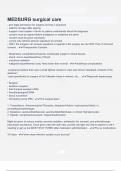STUVIA 2024/2025
MEDSURG surgical care
- give legal permission for surgery and has 2 purposes
- valid for 30 days after signing
- surgeon must explain in terms to patient understands about the diagnosis
- consent must be signed before analgesics or sedatives are given
- consent must be given voluntarily
- nurses only witness persons signature of consent
- ONLY the surgeon can answer questions in regards to the surgery we can NOT. Part of informed
consent. - ✔✔Preoperative Consent
- Respiratory complications/hypoxia: inadequate oxygen to blood tissues
- shock: due to anesthesia/loss of blood
- conscious sedation:
- malignant hyperthermia: body Temp lower than normal - ✔✔Anesthesia complications
-surgical procedure that uses a small lighted camera to view and remove diseased contents of the
abdomen
-used specifically for surgery of the Fallopian tubes in women, etc... - ✔✔Diagnostic laparoscopy
%
• Surgeon
- assistant surgeon
• first Surgical assistant (RN)
• Anesthesiologist/CRNA
• Scrub nurse/tech
• Circulating nurse (RN) - ✔✔The surgical team
1. Tranquilizers: chlorpromazine/Thorazine, diazepam/Valium, hydroxyzine/vistaril, or
promethazine/phenergan.
2. Sedatives: secobarbital/Seconal, pentobarbital/Nembutal, or choral Hydrate/noctec
3. Opioids: morphine/duramorph, meperidine/Demerol
Might be given to reduce anxiety, promote sedation, antiemetic (for nausea), and anticholinergic
(decreases secretions). Once given raise the side rails, provide call light and inform patient to call if
needing to get up but MUST STAY IN BED after medication administration. - ✔✔Pre-op medications
3-6 days - ✔✔when does infection usually occur post-op?
stuvia
, STUVIA 2024/2025
a plastic, air filled sleeve that is placed around the leg and inflates and deflates regularly to help
improve circulation, reduce fluid build up, and prevent blood clots - ✔✔sequential compression
device (SCD)
Age, nutritional status, fluid and electrolyte balance, medical diagnosis, drugs, and habits -
✔✔Variables affecting surgical outcome
Also monitor acute pain, acute confusion, risk for injury, patients family, etc - ✔✔Post op
Are usually removed after 7-14 days - ✔✔Sutures and Staples
Assess respiration frequently to ensure the patient is recovering from medication accurately. Be
prepared to administer antidote if patient is not recovering properly. Usually naloxone/narcan or
flumazenil. Check wound dressing. Vital signs also need to be monitored every 5-15 minutes
according policy. Patient needs to be NPO/nothing by mouth until the gag reflex returns in order to
protect the airway. Important to prevent hypothermia so provide lots of warm blankets, etc... assess
and look for signs/symptoms of hemorrhage/shock which are: vital sign changes, LOC, pale,
bradycardia, shaking, Diaphoretic (excessive sweating). Need to prevent DVT and assess for them.
Encourage patient to do breathing exercises to increase and ensure adequate oxygen saturation.
Monitor for infection: temperature increase, WBC count increase, increased heart rate, observe
%
surgical sight for drainage, redness, swelling, Oder, etc... - ✔✔post-op
bruising - ✔✔Ecchymosis
Bursting open of a wound, especially a surgical abdominal wound
Increases if wound is infected, malnutrition, obesity, dehydration, etc... - ✔✔Dehiscence
Checking respirations, heart rate, fever, chills, profuse sweating (diaphoresis). Increased WBC,
edematous skin at incision sight (edema). Also checking for warmth, tender, smelly, painful,
inflammation, bleeding (excessive), ecchymosis (bruising), redness, drainage, and edema incision.
We also need to maintain patency of the drains, along with assessing the drainage amount, color, and
consistency. Administer anti as prescribed. - ✔✔Data Collection post-op
Clean sutured incision - ✔✔First (primary) intention healing
Closed with sutures, staples, tape, etc.. - ✔✔incision
Diabetes mellitus or immunocompromised. - ✔✔What makes a patient more at risk for infection or
slow wound healing?
stuvia




